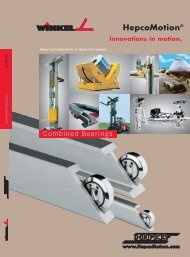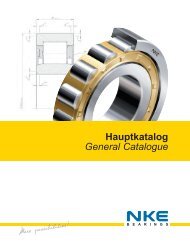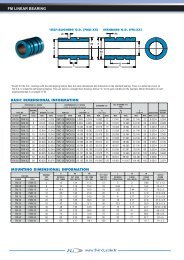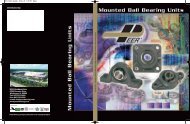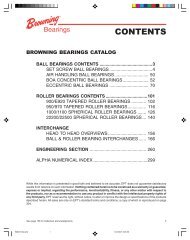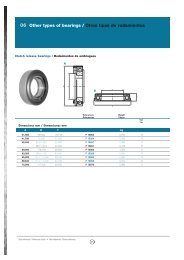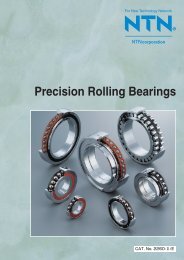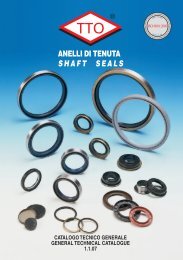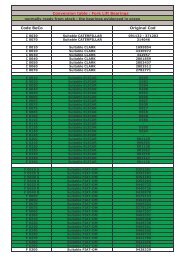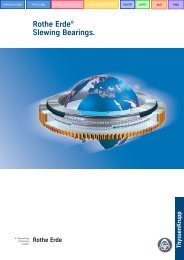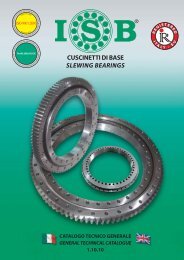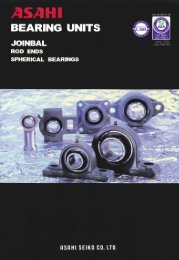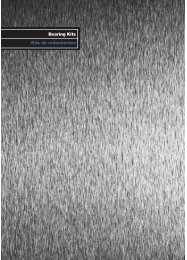LINEAR MOTION SYSTEMS
LINEAR MOTION SYSTEMS
LINEAR MOTION SYSTEMS
Create successful ePaper yourself
Turn your PDF publications into a flip-book with our unique Google optimized e-Paper software.
Simplicity ® Ball Bearings<br />
Technical Information<br />
Linear Motion Systems<br />
RATING LIFE (cont.)<br />
Technical Information<br />
Hardness Factor (fH) -<br />
The shaft must be sufficiently hardened when a linear bushing<br />
is used. If not properly hardened, permissible load is lowered<br />
and the life of the linear ball bearings will be shortened.<br />
FIG. 1 - HARDNESS FACTOR<br />
Hardness Factor fH<br />
1.0<br />
0.9<br />
0.8<br />
0.7<br />
0.6<br />
0.5<br />
0.4<br />
0.3<br />
0.2<br />
0.1<br />
60<br />
50 40<br />
30 20 10<br />
Temperature Coeffi cient (fT) -<br />
If the temperature of the linear system exceeds 100°C,<br />
hardness of the linear system and the shaft lowers to<br />
decrease the permissible load compared to that of the linear<br />
system used at room temperature. As a result, the abnormal<br />
temperature rise shortens the rating life.<br />
FIG. 2 - TEMPERATURE COEFFICIENT<br />
Temperature Coefficient fT<br />
1.0<br />
0.9<br />
0.8<br />
0.7<br />
0.6<br />
0.5<br />
100 150 200 250<br />
Temperature of Linear System (°C)<br />
NOTES: Maximum temperature of plastic retainer 212°F or 100°C.<br />
Maximum temperature 176° per Table 6.<br />
Contact Coeffcient (fc) -<br />
Generally two or more linear bearings are used on one shaft.<br />
Thus, the load on each linear system differs depending on<br />
each processing accuracy. Because the linear bushings are<br />
not loaded equally, the number of linear bushings per shaft<br />
changes the permissible load off the system.<br />
TABLE 2 - CONTACT COEFFICIENT<br />
NUMBER OF <strong>LINEAR</strong> <strong>SYSTEMS</strong> PER SHAFT<br />
Load Coeffi cient (fw) -<br />
When calculating the load on the linear system, it is<br />
necessary to accurately obtain object weight, inertial force<br />
based on motion speed, moment load, and each transition<br />
as time passes. However, it is difficult to calculate those<br />
values accurately because reciprocating motion involves the<br />
repetition of start and stop as well as vibration and impact.<br />
A more practical approach is to obtain the load coefficient by<br />
taking the actual operating conditions into account.<br />
TABLE 3 - LOAD COEFFICIENT<br />
OPERATING CONDITIONS<br />
Operation at low speed (15m/min.or less)<br />
without impulsive shock from outside<br />
Operation at intermediate speed (60m/min.or<br />
less) without impulsive shock<br />
Operation at high speed (over 60m/min.) with<br />
impulsive shock from outside<br />
CONTACT COEFFICIENT fc<br />
1 1.00<br />
2 0.81<br />
3 0.72<br />
4 0.66<br />
5 0.61<br />
fw<br />
1.0 to 01.5<br />
1.5 to 2.0<br />
2.0 to 3.5<br />
The data and specifi cations in this publication have been carefully compiled and are believed to be accurate and correct. However, it is the responsibility of the user to<br />
determine and ensure the suitability of Pacifi c Bearing® products for a specifi c application. Pacifi c Bearing’s only obligation will be to repair or replace without charge,<br />
any defective components if returned promptly. No liability is assumed beyond such replacement. *Consult www.pacifi c-bearing.com for the latest technical updates.<br />
90<br />
800.962.8979 • www.pacific-bearing.com



